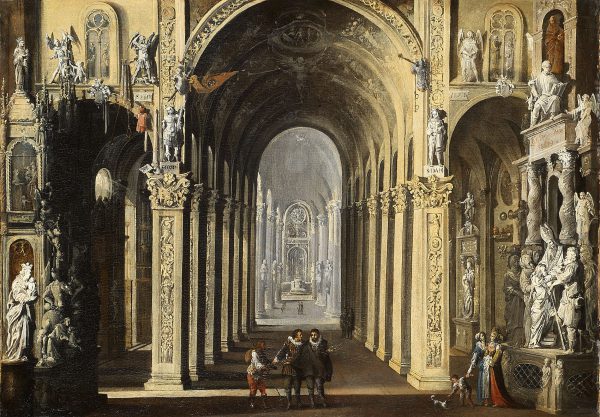Inside the Church Santa Maria delle Grazie Maggiore, Caponapoli, Naples 1619, 1619
Oil on canvas, H. 0.51 m; W. 0.71 m
Inscribed on the columns: S COSM. S. DAM, dated 1619.
Provenance: Collection Urso, Rome.
Private collection, France.
- Félix Sluys, Didier Barra et François de Nomé dits Monsù Desiderio, Paris, 1961, p. 65, no. 26.
- Maria Rosaria Nappi, François de Nomé e Didier Barra, l’enigma Monsù Desiderio, Milan, 1991, p.128, no. A 65 (ill.).
- Musées de la Cour d’Or, cat. exp. Enigma Monsù Desiderio. Un fantastique architectural au XVIIe siècle, Metz, 2004, p.128-129 et p.142-143 (ill.).
It is only in recent years that the mysterious painter called “Monsù Desiderio” has been separated into two artists: Didier Barra and François de Nomé, both from Metz, Lorraine. Didier Barra usually painted topographical views, chiefly of Naples. François de Nomé was a painter of architectural capriccios and church interiors, often imaginary and plunged sometimes into a disastrous chaos, earthquakes or fires. Both painters spent their entire careers in Naples but never assimilated any of the local influences. They both retained a form of archaizing mannerism of a similar type to that of Claude Deruet. At their best, François de Nomé’s pictures excite by their power of expression, even though they seem flagrantly to disobey almost every rule of art. The collaboration between these two artists remains to be brought to light. Did Didier Barra, after the death of François de Nomé, take over his workshop?
The present picture is inspired by the interior of a Renaissance church in Naples: Santa Maria delle Grazie a Caponapoli. Its roman arches are supported by pillars decorated with grotesques and with bas-reliefs showing candelabras, dolphins, mascarons, symbols of the passion of the Christ, and the life of the Virgin Mary. These bas-reliefs were executed in the 16th century by artists from Nothern Italy. This kind of Renaissance decoration strongly inspired Nomé, who repeated it in other paintings. Numerous details, such as the archangels of the upper register and the small groups of persons inspired by engravings from the northern school, maybe by Holbein, points to the painter’s northern culture. The figures, e.g. the child who plays with the dog, show rather conventional attitudes and are close to similar subjects treated at the time by Henrik von Steenwijck the Elder in Antwerp.
But contrary to the Flemish tradition, the building shown here by Nomé is closer to a theatrical view than to a topographical view of a church interior. The foreground where the figures are placed is a proscenium, and the Gothic chapel to the left and the big decorated altar to the right are reminiscent of a stage curtain.
